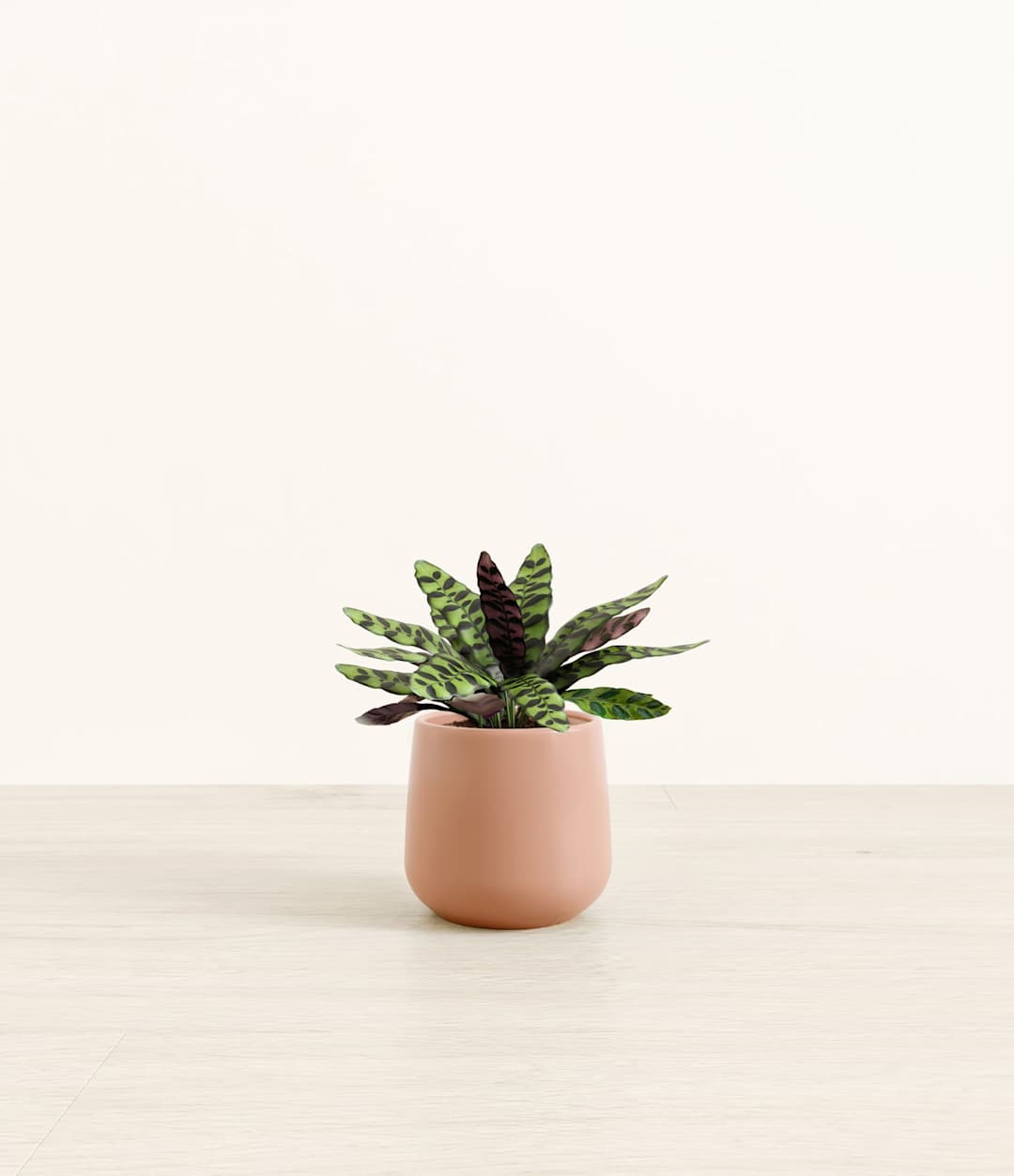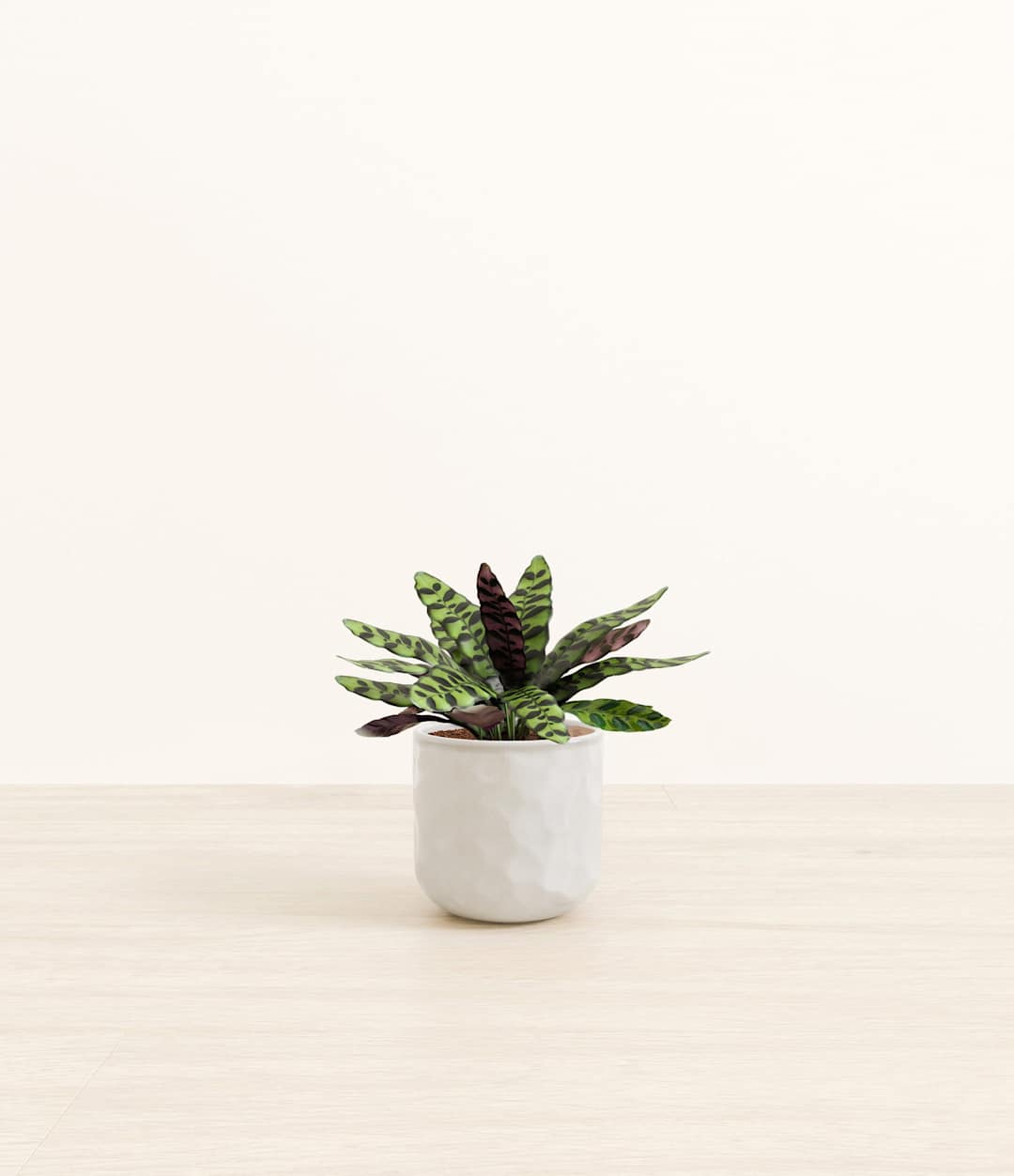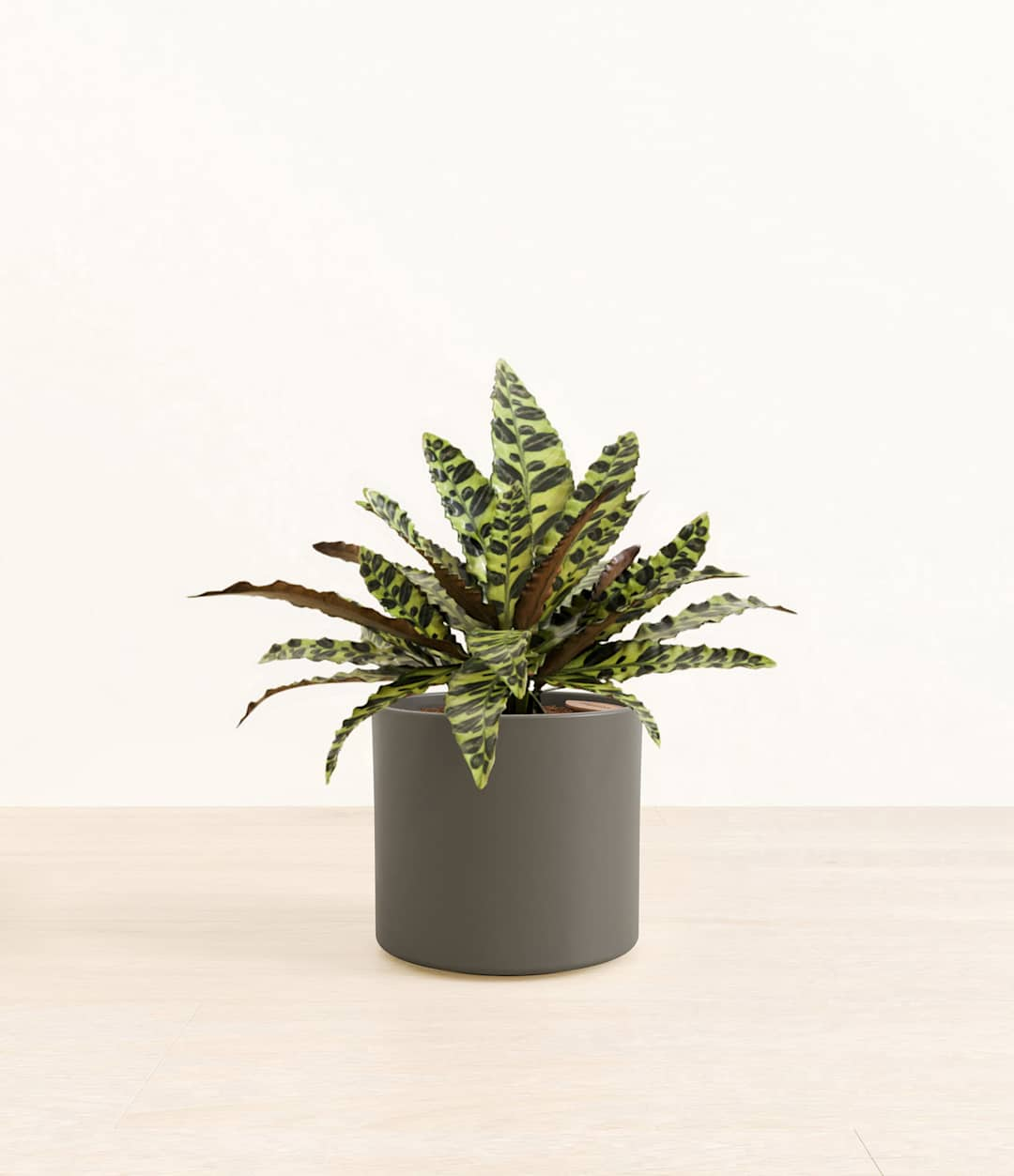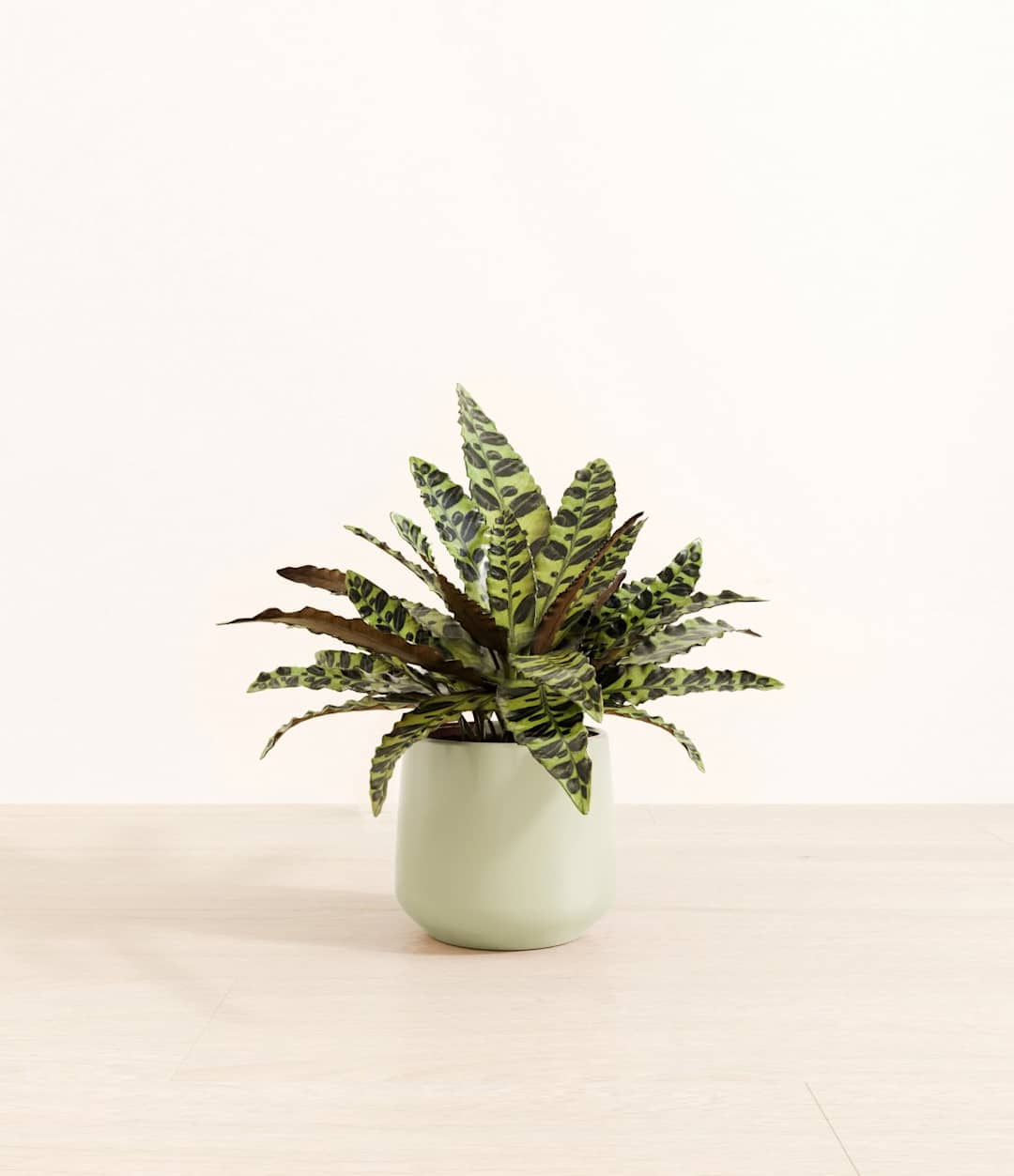About Rattlesnake Calathea
Native to the Amazonian jungles of South America, Rattlesnake Calathea wears an eccentric reptilian pattern on its leaves, with a plum underside and lush green brushstrokes on top.
It belongs to the Marantaceae family, known as 'Prayer Plants,' which, much like humans and unlike most plants, have a wake-and-sleep cycle according to a circadian rhythm. This means its leaves move upwards during the night and downwards throughout the day in search of the sun.
Other common names
- Calathea Lancifolia
- Prayer Plant
- Rattlesnake Master
- Rattlesnake Plant
- Goeppertia insignis
How Often Should I Water My Rattlesnake Calathea?
Self-watering is the best option for Rattlesnake Calathea. To avoid overwatering, underwatering, or simply avoid such a frequent watering schedule, using a self-watering pot will allow the Rattlesnake Calathea to absorb just the right amount of water it needs without having to worry about watering it yourself. With easyplant, watering your Rattlesnake Calathea is simple. Make sure to check the easyplant reservoir once a month and fill it when empty, and you're all set!
If you don't have an easyplant, ensure the soil of your Rattlesnake Calathea remains evenly moist. However, it's important not to let it sit in too much water or become overly dry. To avoid this, check the surface of the soil and water when necessary - once a week (or more in dry climates) should do it.
Rattlesnake Calathea Light Needs
Rattlesnake Calathea grows best in a space with bright indirect light, where the sun rays are diffused, and can also adapt to spaces with bright direct light, where the sunlight streams inside directly. Avoid placing it in spaces with low light or spaces without natural sunlight to keep its characteristic vibrant colors intact.
Native to the tropical forests, Rattlesnake Calathea flourishes in medium, indirect light. A small amount of direct sun early on is acceptable; however, midday or afternoon sunlight should be evaded altogether. An east-facing window is a fantastic option, while south and west-facing windows can also do the job, provided curtains are used or placed several feet away from any direct lighting source.
Rattlesnake Calathea Plant Care
On your Rattlesnake Calathea’s first few days at home, avoid moving the pot around once you choose its placement and allow it to adjust to a stable environment. To help it grow optimally and evenly, occasionally dust the leaves and rotate the pot by a ¼ turn once a month. You may prune old leaves to assist the new growth.
How Big Do Rattlesnake Calathea Plants Grow?
Rattlesnake Calathea grows slowly and steadily until reaching about two feet in height. Once mature, it will keep growing new leaves to replace older ones. When it grows several new leaves at a time, it will normally lose one or two leaves from the bottom.
In as little as a year or two, the Rattlesnake Calathea matures to its fullest growth of 2 feet. From there on out, it will get bushier but no longer increase in height. With proper care and attention, these plants have been known to produce several new leaves every month from spring until summer!
Bright, indirect light, high humidity, and potting soil that stays damp but not wet will help the Rattlesnake Calathea grow in a healthy way. Remember that this houseplant loves a rest period, so you may see it slow down its growth during the winter months when it is dormant.
Temperature & Humidity
With tropical origins, rattlesnake calathea plants thrive in warm environmental conditions, preferably between 65°F-85°F (18°C-30°C). To keep these beloved houseplants from experiencing any cold damage, try to maintain a temperature of at least 60°F (15°C).
Moreover, for your Rattlesnake Plant to look its best, ensure that the humidity levels reach 50% or higher - similar to their native rainforest habitat.
Are Rattlesnake Calathea Toxic for Pets & Kids?
Rattlesnake Calathea is non-toxic and safe for humans and animals alike. This plant is pet-friendly and makes a great addition to any home with kids or pets. To ensure that your furry friends don't accidentally munch on the leaves, place your houseplant in an area where they won't be tempted.
It's important to remember that excessive consumption of the plant may lead to minor distress or an upset stomach; however, rest assured that it is non-toxic and won't result in any serious complications.
Troubleshooting Common Problems with Rattlesnake Calathea
If you notice leaves are curling, relocate the pot to a less brightly lit location. Similarly, if the lower leaves start to become yellow - while this may be the natural aging process - it could also signal overwatering.
Brown leaf tips are normally an effect of dry air with inadequate humidity levels; increase these accordingly for optimal results! Cold temperatures and overwatering can lead to limp stems, which can be damaging and even fatal for your plants if not addressed promptly.
Frequently Asked Questions about Rattlesnake Calathea Plant
Is Rattlesnake Calathea poisonous?

Rattlesnake Calathea is non-toxic and safe for humans and animals alike. If the plant is ingested in large quantities, it may lead to an upset stomach or very mild irritation, but it will not cause any serious complications. It is important to keep the plant out of reach of children and pets, just in case.
Where do you place a Calathea rattlesnake?

Rattlesnake calatheas should be placed in a location away from direct sunlight, preferably one that gets indirect light. You'll want to avoid very cold temperatures and hot drafts, as the plant can easily become distressed in such conditions. East-facing windows are ideal for this plant; if you keep it indoors, rotate the pot monthly to allow even growing.
Should you mist Rattlesnake Calathea?

No, misting Rattlesnake Calathea is not recommended, as it can lead to fungal issues and attract pests. Instead, consider alternative methods to provide the necessary humidity. Start by placing your plant in a room with naturally high humidity levels, such as a kitchen or a bathroom. Additionally, grouping your plant with other plants can create a more humid microenvironment. Another effective approach is to use a humidifier or place the plant on top of a pebble tray with water to maintain the desired humidity.
How do you take care of a Calathea rattlesnake?

Taking care of a Calathea Rattlesnake is easy. Keep its soil evenly moist, avoid midday or afternoon direct sunlight, and maintain warm temperatures and high humidity levels.
Additionally, occasionally dust the leaves and rotate the pot monthly for optimal growth. With an easyplant self-watering pot, you can be sure to provide your plant with sufficient water without worrying about watering frequency.





